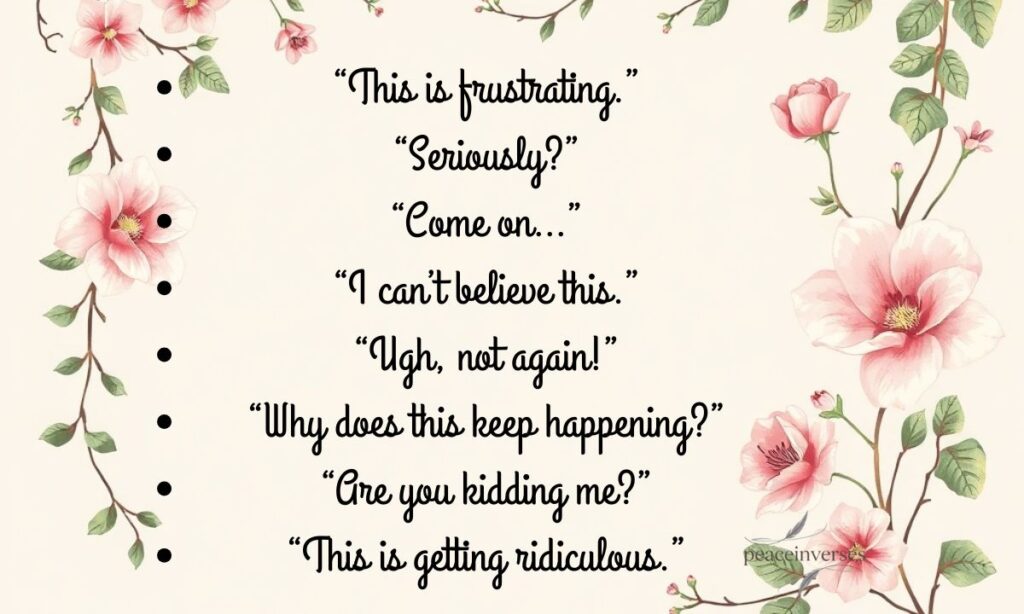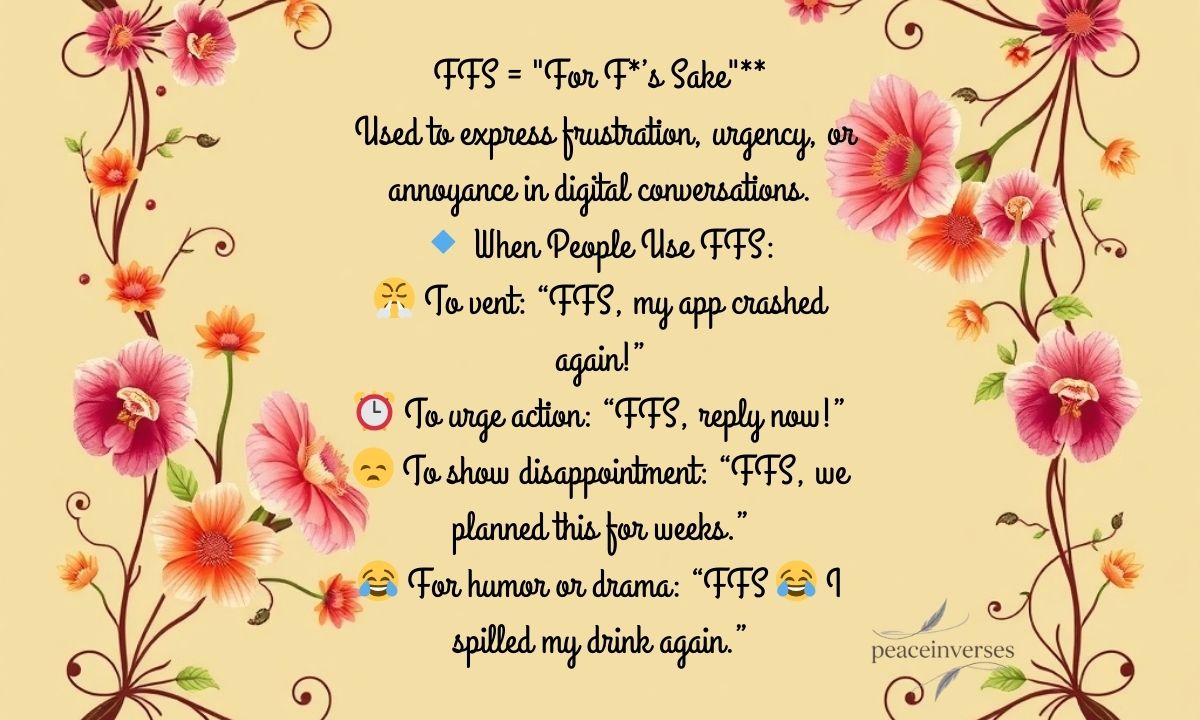FFS pops up in texts, memes, and comments every day, but not everyone knows what it really means. This short abbreviation often shows frustration or urgency without writing a full sentence. If you’ve ever paused at FFS in a chat, you’re not alone—many still wonder what it stands for.
In 2025, FFS is more than slang; it’s part of online culture and quick communication. Learning its meaning and tone helps you avoid awkward misunderstandings in texts and social media. This guide explains the definition, usage, and polite alternatives so you can use it confidently.
What Does FFS Mean in Text?
FFS stands for “For F*’s Sake”** and is used to show quick frustration, impatience, or disbelief in messages. People use it because it expresses a strong reaction in just three letters. It is an informal slang term that reads bluntly on screen. Knowing this meaning helps you decide when the abbreviation is appropriate.
The Tone of FFS in Text Messages
The tone of FFS depends on context and relationship. With close friends it often reads as annoyed but playful, while with strangers it can sound sharp or hostile. Small cues like punctuation, emoji, or timing change how it lands.
The same letters can carry different volumes of emotion. All caps or multiple exclamation marks make FFS feel angry. A trailing laughing emoji or “lol” can flip it to joking. Tone lives in those tiny extras, so pay attention.
People often misread tone because text lacks voice. What feels like casual venting to one person may feel like an attack to another. That gap is why choosing tone markers matters when you use FFS.
- Mild: FFS (no extras) = light annoyance.
- Angry: FFS!!! or FFS, WHY = strong anger.
- Playful: FFS 😂 or FFS lol = joking or self-deprecating.
Key Insight About FFS in 2025
In 2025, FFS remains a common part of online shorthand and informal chat. It is used across platforms from messaging apps to social comments, often combined with media like GIFs or emojis. The abbreviation stays popular because it is concise and emotionally direct.
Language trends show more mixing of text and visuals to manage tone. People add emojis to soften rude words or GIFs to make sarcasm clear. That means FFS is rarely used in isolation; it usually comes with a tone cue.
At the same time, awareness about respectful communication is higher now. Professionals and mixed groups tend to avoid FFS even if casual users keep using it. This split makes it important to match your audience before typing the abbreviation.
- Trend 1: More emoji/GIF pairing to clarify tone.
- Trend 2: Younger users keep it casual; professional spaces avoid it.
- Trend 3: Abbreviation persists because it is fast and expressive.
When and Why People Use FFS
People reach for FFS when they need to communicate a strong feeling fast. It saves time and signals emotion without a long sentence. Often it appears in fast-moving conversations where people expect immediate, emotional reactions. This makes it a go-to in group chats, live comment threads, and frantic messaging.
Another reason is habit and cultural exposure. Users who grew up with internet slang see FFS as normal shorthand. It also fits into a broader pattern of compressing language for speed. That comfort leads people to default to FFS in moments of irritation.
FFS is also used as a tone setter. A quick FFS can tell the recipient the sender is upset and wants attention. But because it’s blunt, it needs context to avoid escalating conflict. Choose it when you want to be direct and the relationship can take the heat.
- To vent: immediate emotional release.
- To urge action: signals urgency.
- To react: shorthand for frustration in fast threads.
Expressing Frustration or Annoyance
When used to show frustration, FFS usually replaces a longer complaint. It gives instant clarity: the sender is fed up. That clarity is useful when time is short or when the issue repeats. However, the bluntness can alienate recipients who expect softer language.
In close groups, FFS can be an accepted way to commiserate or vent together. Among friends you might see it after a long string of small annoyances. In public threads, however, that same line can be perceived as rude. The difference comes down to shared norms and expectations.
Use concrete examples to show how it functions. Saying “FFS, the app crashed” tells the reader both the problem and the sender’s feeling. The message is efficient, but it also leaves little space for nuance. If you want to repair tone later, follow up with context or a softer line.
- Example: FFS, the app crashed again — direct, immediate, emotional.
- Example: FFS, I told you already — signals impatience and repetition.
- Example: FFS, why does this always happen? — expresses resignation plus annoyance.
Showing Urgency or Disappointment
FFS can add weight and urgency to a short instruction or plea. When time matters, three letters can make a demand feel pressing without a long explanation. That makes it common in emergency-style texts, last-minute plans, or when someone is not responding. .
As an expression of disappointment, FFS communicates that expectations were not met. It condenses regret and annoyance into a quick response. This is useful after cancellations, missed deadlines, or repeated mistakes. But because it implies blame, it risks escalating tension.
When you need action without sounding abusive, pair FFS with polite direction. For example, “FFS, please call now” combines urgency with a clear ask. If you only write FFS, the recipient may not know what you want them to do next.
- Urgent: FFS, call me now — demands immediate response.
- Disappointed: FFS, we planned this for weeks — signals letdown.
- Tip: Add an action to avoid vague blame.
Adding Humor or Dramatic Effect
Among friends, FFS often plays a comic role rather than an offensive one. Used with a laughing emoji or self-deprecating line, it becomes theatrical. That dramatic flair helps make mundane mishaps into shared jokes. Still, humor in text depends on shared style and prior rapport.
Writers and creators use FFS for comedic timing in captions and memes. The abruptness gives a punchline instant impact, especially when paired with a relatable image.Outside those circles, the same line may read as harsh.
If you want to be funny, add signals that show intent. Emojis, laughs, or a clarifying sentence after FFS tell readers you mean it in jest. Without those cues, your attempt at humor might land as annoyance.
- Playful: FFS 😂 spilled coffee again — self-mocking and light.
- Dramatic: FFS, the finale was ruined — theatrical, relatable.
- Advice: Use markers like emoji or follow-up lines to cue humour.
Is FFS Rude or Acceptable in Texting?
FFS sits on a line between frankness and rudeness depending on audience. Because it stems from a taboo word it can offend people who dislike strong language. In private groups it may be normal, while in public or mixed-age spaces it often reads as inappropriate.
Cultural and generational differences matter a lot here. Younger users frequently tolerate or expect such abbreviations, while older users may take offence. Workplace norms also vary, with many organisations discouraging any coarse language. When in doubt, choose a safer phrase.
Acceptability also changes with the seriousness of the topic. Using FFS in a light complaint differs from using it during conflict or sensitive situations. The higher the stakes, the less suitable blunt expletives become.
- Factors: audience age, relationship, platform, topic sensitivity.
- Safe rule: avoid in formal or mixed-audience settings.
- Balance: be direct when necessary, but prefer clarity over shock.
When to Avoid Using FFS
Avoid FFS in any professional or formal communication. Business emails, client chats, and workgroup messages are usually poor places for strong slang. It undermines credibility and can offend colleagues or supervisors. If you need to express frustration at work, choose calm, specific language.
Do not use FFS when discussing sensitive personal matters. In arguments, health issues, or serious disputes, the abbreviation can escalate conflict. It signals contempt more than concern. In those moments, a measured sentence will communicate your point without inflaming the situation.
Also avoid FFS with people you do not know well, or where cultural norms differ. If you are unsure how language is received, pick a neutral alternative. Good communication often means sacrificing a punchy shorthand for clarity and respect.
- Where to avoid: work chats, formal groups, messages to elders.
- When risky: during sensitive conversations or conflicts.
- If unsure: use a polite alternative like “This is frustrating” or “Please respond.”
Situations Where FFS Is Fine
FFS is usually fine in private, casual spaces where people share tone and humour. Close friends, private groups, and gaming parties are common places you will see it. In these settings it functions as expressive shorthand rather than an insult. Still, even among friends, moderation keeps it effective.
Social media communities that accept strong language also treat FFS as normal for dramatic flair. Memes, reaction threads, and informal comment sections often welcome that blunt shorthand.
Finally, FFS is suitable when you want fast emotional clarity and you know the recipient. If you need to vent quickly to someone who understands you, FFS does the job. Use it when speed and shared context matter more than politeness.
- Good contexts: close friends, private group chats, casual gaming.
- Community fit: accepted on many social platforms and meme spaces.
- Use tip: keep it occasional so it retains impact.
Polite Alternatives to FFS in Text

Sometimes you need to show frustration without sounding rude. A few polite phrases can keep your tone calm and respectful. They help you share the same feeling while avoiding strong words.
Professional Alternatives to FFS for Work Chats
In work chats, slang like FFS can harm your image. Replacing it with neutral phrases shows professionalism and keeps the message clear. Good alternatives focus on the problem, not emotions, which helps teamwork.
You can use polite phrases to reduce tension in stressful work situations. Instead of sounding angry, they highlight the issue so colleagues know what to fix. A calm message is more likely to get a positive response and quick action.
Try swapping FFS for constructive words. This keeps conversations productive even when you’re frustrated. Here are some safe replacements:
- “This is really frustrating.”
- “Can we address this quickly?”
- “This keeps happening—let’s find a fix.”
Casual Alternatives to FFS for Friends and Peers
With friends, you often want to keep the fun and relaxed tone. Slang feels natural, but you can still avoid FFS if you think it’s too harsh. The goal is to stay expressive while keeping the mood friendly.
Some words or emojis can capture the same vibe without offending anyone. These alternatives work especially well in playful chats or inside jokes. You can be dramatic or funny without crossing a line.
Here are a few good swaps:
- “Oh come on…” – light irritation
- “Ugh, not again!” – casual frustration
- “Seriously?!” – playful disbelief
How to Pick the Right Alternative (Tone Matters)
Tone matters as much as the words you choose. The same phrase can feel rude or kind depending on context and punctuation. Always match your choice to the relationship and situation.
If you’re talking to a manager, avoid slang and choose a formal tone. With close friends, an informal option might feel natural. Think about how the other person might hear your words before sending.
Emoji, punctuation, and length also affect tone. A single exclamation mark or a smiley face can change the mood entirely. Keep these points in mind:
- Audience: friends vs. coworkers
- Purpose: venting vs. asking for action
- Tone markers: emojis, punctuation, added words
12 Real Examples of FFS in Text Conversations (2025)
1. “FFS, my laptop froze again!” — Tone: annoyed but casual.
2. “FFS, I just missed the bus…” — Tone: frustrated and resigned.
3. “FFS 😂 I spilled my drink again” — Tone: playful and self-mocking.
4. “FFS!!! Can someone answer already?!” — Tone: urgent and upset.
5. “FFS, it’s raining on the wedding day” — Tone: disappointed and dramatic.
6.“FFS lol I forgot my keys again” — Tone: light-hearted and teasing.
7.“FFS, the meeting’s moved again…” — Tone: annoyed but controlled.
8. “FFS, why do these updates take forever?” — Tone: impatient and venting.
9. “FFS 😭 I lost the game at the last second” — Tone: sad but humorous.
10. “FFS, we’re stuck in traffic for an hour” — Tone: frustrated yet calm.
11. “FFS!!! The server crashed during the launch” — Tone: urgent and alarmed.
12. “FFS, can’t believe I slept through the alarm” — Tone: frustrated with self.
Related Slang and Abbreviations You Should Know
Understanding other common slang helps you keep up with casual conversations. Many share the same tone as FFS and pop up in texts, memes, or group chats. Knowing them avoids confusion and helps you respond properly.
Some slang shows feelings quickly, just like FFS. Others are useful for humor, agreement, or dramatic reactions. Add them to your texting style when the context allows.
Here are a few examples worth knowing:
- WTF: expresses shock or disbelief.
- SMH: “shaking my head” for disappointment.
- IDK: means “I don’t know,” often casual.
- OMG: shows surprise or excitement.
- TBH: “to be honest,” softens blunt opinions.
Why FFS Remains Popular in 2025
FFS stays popular in 2025 because it’s fast, emotional, and widely understood. People want shortcuts that show feelings in just a few letters. This abbreviation works across texting, gaming, and social media without needing extra words.
Its mix of humor and frustration makes it stand out. Friends use it to vent, laugh, or share dramatic reactions, often adding emojis for effect. Even as new slang appears, FFS keeps its edge because it’s simple and flexible.
You’ll still see FFS in memes, comments, and chat threads every day. It’s part of internet culture now, showing that some slang sticks around when it’s short and expressive enough to fit almost any casual mood.
Final Words
Using FFS well means understanding tone and timing. It’s fun with friends but risky in work chats or formal spaces. If you’re unsure, a polite phrase or emoji often works better.
Keep your audience in mind. A single FFS can sound funny in a group chat yet rude in a professional email. Balance emotion with respect to avoid misunderstandings.
FFS is likely here to stay, so it’s worth knowing how to use it wisely. Pick your moments carefully, and you’ll keep your messages sharp, relatable, and appropriate.

Muhammad Shoaib is a passionate faith-based writer with over 10 years of experience in creating meaningful content centered around prayers, Bible meanings, scriptural teachings, and heartfelt wishes. He is the lead writer at PeaceInVerses.com, where he shares spiritual insights and uplifting messages to guide and inspire readers on their faith journey.

